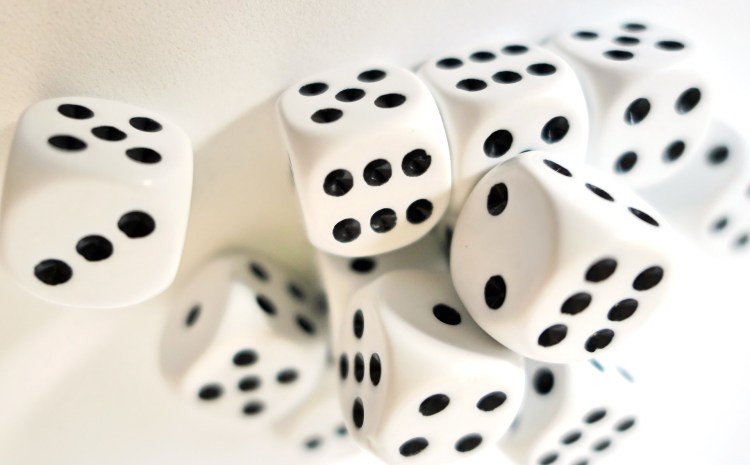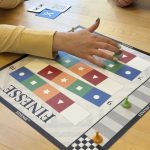From Michael Wiesenberg this week: many betting systems are based on gambler’s fallacy, having the player increase or decrease bets when winning — or when losing — but it doesn’t work.
Gambler’s Fallacy

Gambler’s Fallacy
In craps, a pass is an initial roll that wins immediately or establishes and makes a point. The immediate win is a come-out roll (first) of a 7 or 11; an immediate loss is a come-out roll of 2, 3 or 12. If one of those does not come up, then a point is established. A point is the total on the first roll of 4, 5, 6, 8, 9, or 10. The player (or shooter) keeps rolling the dice until either the established point is rolled (the player makes the point) or a 7 comes up. If a 7 appears, the player has crapped out (or sevened out) and the dice go to the next player to start a new run. Each successful outcome (throwing a 7 or 11 right away or establishing and then making a point) is called a pass.
I was in a casino at South Lake Tahoe when news of an exciting craps table event started spreading among the patrons. A woman seemed to be in the midst of a long streak of passes. The figure I heard was 15 passes. It wasn’t hard to find the craps table that was generating the buzz. Players were gathered three- and four-deep around the table, all chattering loudly as they placed their bets, or, unable to get to the layout, tossed their wagers to the dealers. I think the woman made 25 passes before finally crapping out. During that time, the players betting on her run made tens of thousands of dollars. What made the event even more unusual was that the “lucky” shooter, who had started out betting $2 per come-out had scaled back to $1. She made maybe $40 during her extended time of holding the dice. Many of the players increased their bets rapidly to take advantage of the perceived winning streak — some letting the bet ride (that is, wagering double on each come-out) until they reached the table limit and could bet no higher, but leaving that maximum for the next wager.
I heard onlookers tsk-tsking that she hadn’t taken advantage of the hot streak by increasing her bet each roll, thereby winning herself a bundle. And remarking how ironic it was that the gamblers riding her streak made such killings when she won only $40.
And There We Have Gambler’s Fallacy
Gambler’s fallacy takes two forms. One states that a series of events will continue. If a player makes several passes in a row on the craps table, the expectation is that the player will continue to make passes. Or if red is observed to come up several times in a row on a roulette table, red should come up on the next spin, so that is the time to bet on red. The other form of gambler’s fallacy states that a series of events makes it more likely that the streak will end. If red is observed to come up several times in a row on a roulette table, black is more likely to come up on the next spin. The underlying “logic” behind the second contentions is that events that have about a 50-50 expectation tend to “even out” in the long run, so if red comes up 10 times in a row black is “due.” It is certainly true that over a very long series of, for example, tosses of an unbiased coin (one that is equally likely to come up heads or tails), the number of heads and tails will be equal. But that this is the expectation in a relatively short series is a fallacy. On one toss, the chance of heads is 50%. If heads comes up 10 times in a row, the chance of heads on the next toss is still exactly 50%. Coins have no memory. Neither do dice or roulette wheels. Each event is independent of every other event, and is not affected by anything that happened before.
This kind of event is called sampling with replacement, and is the operating principle in craps, roulette, coin flipping, and the like. Compare this with sampling without replacement. An example is a sock filled with 50 black marbles and 50 white marbles. You reach in and pull out one marble (and cannot see what you grab) at a time. If your first pick is white, there is a slightly greater than 50-50 chance that the next pick will be black. Out of 99 remaining marbles, 50 are black and 49 are white. The chance on the next pick of getting a black marble is 50 out of 99 or about 50.5%. If the first 10 picks are all white, the chance on the next pick of getting a black marble is 50 out of 90 or about 55.5%. If, by the way, the drawn marble is replaced each time, you would always be picking a marble from a stock of 50 black and 50 white and this would then be sampling with replacement and each draw would have a 50-50 chance of being white and a 50-50 chance of being black. (Parenthetically, blackjack is sampling without replacement. The removal of cards changes the remaining composition of the deck. For example, on a single-deck game, if the first four cards to come off the deck are all aces, no aces remain. Aces are favorable cards, and a deck with no remaining aces is unfavorable. If, on the other hand, half the deck is dealt and no aces appear, the remainder of the deck is what is called ace-rich, and makes wins more likely. As an extreme example, if the dealer has a 5 showing, and if there remain eight cards among the undealt portion of the deck and they are all 10-count cards and aces, the player would have a huge advantage. Being aware of the constitution of the deck is what card counting is all about. The details of that strategy are way beyond the scope of this article.)
Many betting systems are based on gambler’s fallacy, having the player increase or decrease bets when winning — or when losing — but, as we have seen in my article Betting Systems, it doesn’t work.
Math
A bet on the pass line has a house edge of about 1.414%; the chance, then, of making a pass is about 0.493. Making 15 passes happens approximately 0.0000247 of the time; the odds against are about 40,485 to 1. Making 25 passes happens approximately 0.0000000209 of the time; the odds against are about 4,7733,911 to 1. That’s rare, but it does happen. The longest documented streak was 154 passes. The odds against that happening are approximately 2.003 x 10^47 to 1, or a bit more than the number 2 followed by 47 zeros. That rare occurrence likely has happened no more than once in all the casinos in the world since they have been open, both in physical premises (brick-and-mortar casinos) and online.








